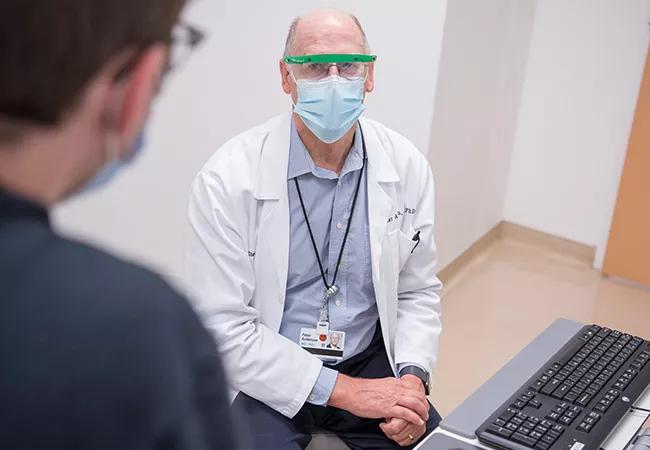Slight deviation from treatment paradigm salvages significant anatomy

A 4-year-old patient presented with a 7.2 cm tumor located in her buttock and was later diagnosed with Ewing sarcoma. The tumor was arising in the coccyx with extension into the gluteal musculature, the pelvic floor muscles and pushing up tightly against the rectum. Her physicians at Cleveland Clinic Children’s say that approaching her treatment with “patience and persistence” helped salvage significant anatomy, potentially preventing lifetime use of a colostomy bag.
Advertisement
Cleveland Clinic is a non-profit academic medical center. Advertising on our site helps support our mission. We do not endorse non-Cleveland Clinic products or services. Policy
Ewing sarcoma can occur any place in the body, although it’s frequently reported in musculoskeletal sites in the extremities and pelvis. The sarcoma-causing mutation is initiated by the fusion of the Ewing gene (EWS) with a partner gene. FLI1 is the most common variant, although there are several other fusion partners. In this case, the patient had the FEV gene rearrangement, an unusual partnering, making the case particularly unique.
Peter Anderson, MD, the patient’s pediatric oncologist, explains that the principles of therapy for Ewing sarcoma, like other sarcomas, is to first shrink the tumor with effective therapy; this is, historically, a 10-week regimen.
“This step is followed by local control, which is almost always either surgery, radiation or both, although the choice of when to do surgery, radiation or both depends on site, size of the tumor and experience of the team,” he says. More chemotherapy often follows this to help prevent recurrence and metastasis of the tumor.
In this case, however, the tumor responded remarkably well to the chemotherapy. The team decided to keep treating it to hopefully make surgery less damaging. The original concern was that the rectum would have to be removed to gain a safe margin on the tumor. However, the tumor continued to shrink with every round of treatment. They used all 14 cycles of treatment before proceeding with the surgery.
Lukas Nystrom, MD, the patient’s orthopaedic oncologist, says this approach reduced the tumor, allowing for a more minimal resection. “We were ultimately able to salvage the rectum, removing only a small part of her tailbone and gluteal muscles.”
Advertisement
The team was elated when postoperative pathology reports showed 100% necrosis of cancer cells, eliminating the need for radiation in a sensitive area. The tumor was effectively treated and the patient’s function was spared.
Drs. Anderson and Nystrom both say that following a conventional treatment paradigm – doing the surgery in the middle of the chemotherapy – would have necessitated significant additional resection of normal anatomy and, almost certainly, would have resulted in the patient needing a colostomy.
When considering this approach, Dr. Anderson says he was confident that such a positive treatment response and the relative size of the tumor was unlikely to result in relapse while the patient was still in therapy.
A single lung nodule was detected on the patient’s scan at follow-up. She was treated with novel outpatient chemotherapy that did not require hospital admission. Her radiation oncologist, Erin Murphy, MD, used stereotactic body radiotherapy to treat the nodule precisely and with no side effects and no sign of recurrence at present. Dr. Anderson reports, “The patient is having a happy, well-adjusted summer.”
She will receive scans every four months, and then less frequently after that. “We can’t promise a cure, but we think she is on her way to becoming a statistical outlier,” he says.
This is a case of persistence and patience, but Dr. Nystrom says Cleveland Clinic Children’s is also well-positioned to handle complex cases like this.
“Not only do we have every specialty involved in cancer care under one roof, but we have them all in one room.”
Advertisement
Cases like this come up at least twice a week during pediatric Ewing sarcoma and pediatric tumor board discussions. The team also recently launched a new National Ewing Sarcoma Tumor Board, a forum that connects experts from Cleveland Clinic and other leading cancer centers.
The strong collaboration and continuity of care among all of the patient’s care team resulted in a personalized plan of care that, ultimately, led to an optimal outcome. Both physicians agree that multidisciplinary care and focused case-related discourse allow the team to think outside the box in ways that engender innovation in care and prioritize the patient.
Dr. Anderson sums it up. “Ultimately, it’s about doing what’s right for the child.”
Advertisement
Advertisement

Supporting patients during pregnancy and beyond

Real-world applications in clinical documentation and trial matching

Q&A with new classical hematology program leader

Patient with TP53 mutation achieves full response with targeted therapy

Concurrent treatment necessary for addressing progressive disease and infection

Psychosocial oncology offers a path forward

A conversation with Marcelo Pasquini, MD

International study supports change in clinical care in post-neoadjuvant setting